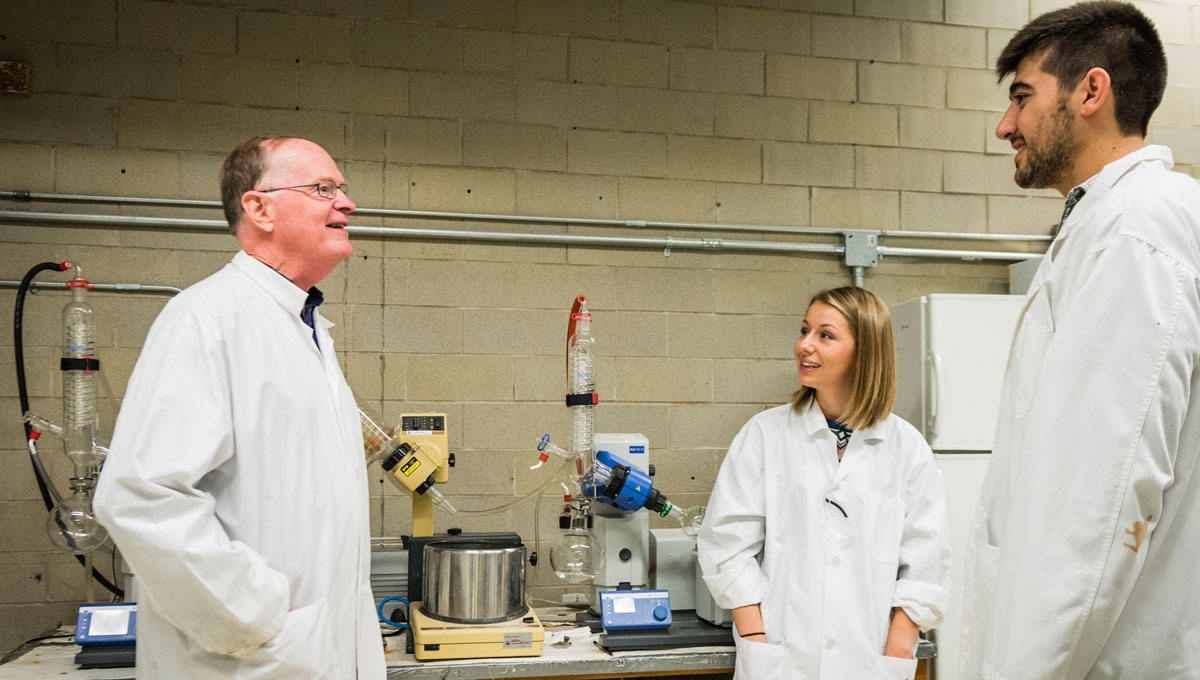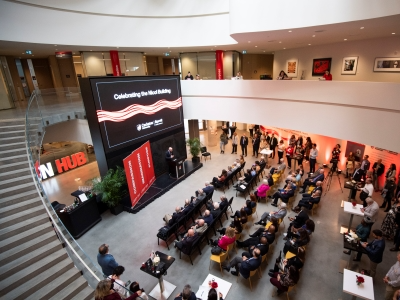By Dan Rubinstein
In a society geared toward quick fixes, patience is a virtue — especially when you work with trees.
J. David Miller, a professor in Carleton’s Chemistry Department, is a winner at this year’s prestigious NSERC Synergy Awards for Innovation for an environmentally sensitive breakthrough that will reduce the devastating impact of the eastern spruce budworm on the forestry sector in eastern North America.
Miller’s discovery, the result of a nearly 20-year-long research collaboration with the woodlands division of J.D. Irving Ltd. (JDI), was inspired by a chance conversation he had at a conference three decades ago.

A colleague wondered aloud whether endophytes (fungi that live inside conifer needles) may produce toxins, propelling Miller into what he describes as “a journey that started as all scientific journeys should: curiosity-driven research that led us to a company that had its own innovative ideas to share.’’
“Together, we discovered things that we did not anticipate, that were not known, about an ecosystem that’s really critical to Canada.”
Research in the 1990s supported by the Natural Sciences and Engineering Research Council (NSERC) allowed the discovery of endophytic fungi in the Acadian forest that produce insect toxins in the needles of conifer seedlings.
“A bunch of us went to NSERC and asked for a lot of money,” says Miller, “to essentially go fishing. This was an enormous project, like looking for a needle in a haystack without knowing what the needle looked like.”
It turned out that conifer endophytes are transmitted to seedlings as they begin to grow on the forest floor surrounded by cast needles from mature trees.

Carleton Chemistry professor J. David Miller is a winner at this year’s prestigious NSERC Synergy Awards for Innovation
Miller, together with Greg Adams of JDI and Maritime Innovation Ltd., investigated how to replicate this process in greenhouses. As a result, JDI now mass‐produces endophytic fungi and has planted more than 100 million endophyte‐enhanced seedlings.
The trees that result have increased tolerance to the spruce budworm — enough of a resistance to significantly reduce the impact of an infestation.
“It’s a perfect story about the arc of science,” says Miller, who has also used the project to give students hands-on access to invaluable training. “Nothing good happens quickly, in particular with trees, because they take a very long time to grow.”
JDI didn’t leap at the opportunity to work with Miller initially. But he received a fax on Nov. 18, 1997 that’s still posted on his office wall. “We’d like to talk,” it read.
“I was given an opportunity,” says Miller, “to ask the right questions.”
The eastern spruce budworm is the most damaging forest insect pest in the country. In the 1970s and 1980s, budworm outbreaks affected 50 million hectares, destroying hundreds of millions of cubic metres of timber and taking a big bite out the economy in eastern Canada.

“As major spruce budworm epidemics occur approximately every 50 to 100 years, finding a sustainable and proactive solution to this devastating problem is of great importance,” Kim Matheson, Carleton’s former vice-president (Research and International), wrote in a letter in support of Miller’s Synergy Award nomination.
“The partnership between Prof. Miller and J.D. Irving, fostered for nearly two decades, has led to remarkable co-creation of knowledge.”
“Dr. Miller and Carleton University have engaged exceptionally well with our team of forest pest experts to work on problems that affect the entire country,” wrote James D. Irving, the co-Chief Executive Officer of JDI. “Together we have developed basic science into applied methods.”
Miller, who is from Saint John, N.B., the province where most of JDI’s forestry lands are located, has a personal interest in this type of research. His family has a woodlot outside the city, and he has spent a lot time walking among the trees.
Miller was an undergraduate student at the University of New Brunswick when the last bad budworm epidemic hit his home province, Nova Scotia and Maine. Keeping the forests green, he recalls, necessitated a spraying program using chemicals that Canada no longer deploys for pest management.

Today, thanks to his collaboration with JDI, which provided the white spruce seedlings and nursery space for him to test theories, tree and forest growth knowledge, foresters have a more effective and environmentally sustainable tool. And this proprietary technology could have applications in the battle against other pests and pathogens. Funding for this research has come from J.D. Irving Ltd., NSERC, Atlantic Canada Opportunities Agency – Atlantic Innovation Fund (ACOA), National Research Council (NRC-IRAP), Mitacs and SERG International.
Miller is the second Carleton professor in two years to win an NSERC Synergy Award for Innovation. In 2015, Richard Amos, an assistant professor in the Department of Earth Sciences, was part of a University of Waterloo-led team that won the prize for the formation of an academic-industry partnership focusing on waste rock that results from mining.
“Science is a team sport,” says Miller, who was celebrated on Parliament Hill and at Rideau Hall on Feb. 16. “None of this would have been possible without lots of different kinds of expertise. This award reflects a lot of work by a lot of people over a long of time. And it’s a recognition of the risks that JDI took.”
After the Ottawa events, Miller went to the Ontario Legislature in Toronto to meet with MPPs as part of the Council of Ontario Universities’ Research Matters gathering, an annual showcase of game-changing research at the province’s universities. This year’s theme was collaborative partnerships with industry.
Photos by NSERC; Lead photo by Luther Caverly
Tuesday, February 16, 2016 in Faculty of Science, Research
Share: Twitter, Facebook



